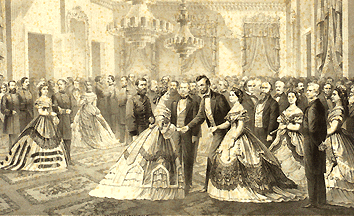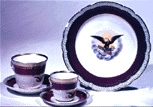
Click on the above image for a detail.
Lithograph: Grand Reception of the Nobilities of the Nation at the White House 1865.
Made by Major & Knapp, Lithographer, New York, NY.
Date: 1865 Id: 00.3.14664
Mrs. Lincoln selects a formal dining service for the Executive Mansion
As First Lady, Mary Todd Lincoln was responsible for entertaining visiting dignitaries in an appropriately formal manner at the White House. But there was a problem. When Abraham Lincoln was elected in 1861, the Executive Mansion did not have even one complete set of dishes. With $20,000 appropriated by Congress for generally refurbishing the President's House, Mrs. Lincoln travelled to New York City to put things right.
On May 16, 1861, she visited the firm of E.V. Haughwout and Co. "Importers and Decorators of French China." Haughwout's had designed dinnerware for the Executive Mansion during the administration of President Franklin Pierce (1853-1857) - a splendid dinner service with a seal of the United States emblazoned on each piece. Although the commission was never approved, Haughwout's highlighted the china at the Crystal Palace Exhibition in New York in 1853. When they showed the pattern to Mrs. Lincoln, she was thrilled. She approved it with one change: instead of the proposed blue border, she asked for a strong magenta color called "solferino."

From the White House China collection,
ID 35.539.15
In September of 1861, Haughwout and Co. delivered the full set of fine porcelain - 190 pieces - decorated in "royal purple and double gilt." It included:
2 bowls for salad
4 shells for pickles
4 meat platters in each of 6 sizes (9", 10", 13", 15", 18", and 20")
4 fish platters in various sizes and forms
2 butter dishes with drainers and covers
6 uncovered vegetable dishes or "bakers"
96 nine-inch dinner plates
48 soup plates
4 large water pitchers
2 bowls for ice
There were also a fine porcelain dessert service of 208 pieces, a breakfast and tea service of 260 pieces and center pieces, and two large punch bowls. Later, still more pieces were added.
The variety of pieces reflects the demands of fashion during those times. When huge formal meals were presented in well-to-do houses, the presentation was far more important than the quality (or hotness) of the food.
[ Pic of the Month ] [ Pic Archive ]

